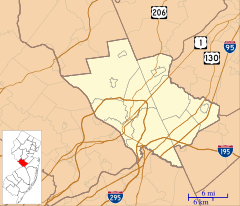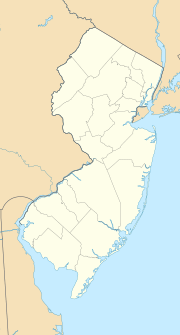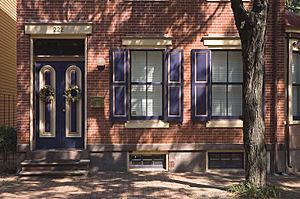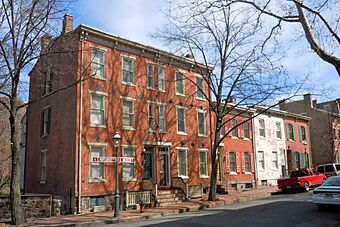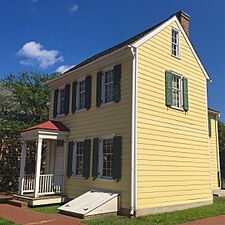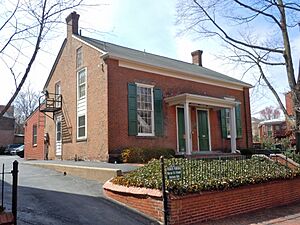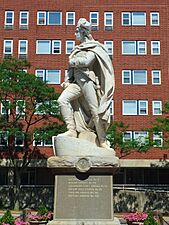Mill Hill, Trenton, New Jersey facts for kids
Quick facts for kids
Mill Hill
|
|
|---|---|
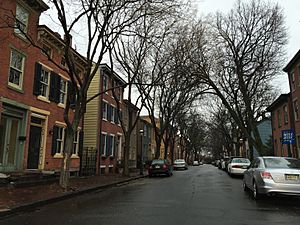
Mercer Street in Mill Hill
|
|
| Country | |
| State | |
| County | Mercer |
| City | Trenton |
Mill Hill is a really old and important neighborhood in the city of Trenton, New Jersey. It's part of Downtown Trenton. This area is so special that its historic buildings and places were added to the National Register of Historic Places in 1977. This means it's officially recognized for its important history and architecture.
Contents
Mill Hill's Early Days and Name Origin
The name Mill Hill comes from the very first industrial site in central New Jersey. This was a mill built in 1679. It stood at the southeast corner of what is now Broad Street, right where it crosses the Assunpink Creek.
This wooden mill and the land around it belonged to Mahlon Stacy. He was a Quaker who arrived in North America in 1678. He was one of the first settlers near Trenton. Sadly, a big flood later destroyed the mill.
A Key Battle in the American Revolution
Mill Hill became famous in the late 1700s because of the Second Battle of Trenton. Many historians believe this battle was a major turning point in the American Revolutionary War.
The battle happened on January 2, 1777. It took place in what is now Mill Hill Park. Every year, people re-enact this important battle during Patriots Week in Trenton.
Growth and Industry in the 1800s
For a while, Mill Hill didn't grow much. It wasn't even part of Trenton yet. In 1840, the whole area became part of South Trenton. Then, in 1851, it officially joined the City of Trenton. People were calling the area "Mill Hill" as early as 1821.
Mill Hill grew very quickly in the 1800s. Trenton was becoming a big industrial city. The Roebling steelworks, for example, made the strong wire cables used in many famous bridges. These include the Golden Gate Bridge and the George Washington Bridge. Trenton was also a main center for making pottery and ceramics in the United States. The Mercer Street Friends Center, a Quaker meeting house, was finished in 1858.
Many immigrants moved to Mill Hill, and the population grew a lot. By 1920, more than half of Trenton's people were born in other countries.
Revitalizing Mill Hill: A Community Effort
During the Great Depression, Trenton's industries started to slow down. By 1953, Roebling Steel, one of Trenton's last big factories, was sold and then closed.
Since the early 1980s, Mill Hill has been getting a fresh start. A special plan was made to turn Mill Hill into a place like "Georgetown," a famous historic neighborhood. Instead of tearing down old buildings, the plan was to save and fix them up.
The red brick row-houses, built in the late 1800s, have been restored. Many of them were changed back into single-family homes. Before, during harder times, many had been split into apartments.
In 1964, Trenton's mayor, Arthur J. Holland, and his wife moved to 138 Mercer Street. This was a big symbolic step for the neighborhood. They wanted to help restore a house in the historic Mill Hill area. Since then, the restoration of the area has continued in waves.
At first, people focused on the 100 blocks of Mercer and Jackson Streets. Some residents started fixing up their homes. In 1967, the first Holiday House Tour happened. This tour became an annual event. It still happens today, with over 1,000 people visiting the historic homes. As these changes happened, house prices got better, and more money was invested in restoring the area.
After a property downturn in the late 1980s, a second wave of renovation began. Companies like Atlantis Historic Properties started fixing up empty buildings on the 200 blocks of Mercer, Jackson, and Clay streets. Atlantis was actually started by people from the Mill Hill community in the early 1990s. Their goal was to save and restore the historic homes, starting with properties at 261 and 263 Jackson Street.
Today, you can see beautifully restored old buildings next to new ones that are built to match the historic style. The Quaker Meetinghouse at 151 Mercer Street also houses the offices of Mercer Street Friends. This group helps people in Trenton and nearby areas.
Mill Hill Historic District: A Special Place
The Mill Hill Historic District is a special area that covers about 31.5 acres. It includes the neighborhood and is generally bordered by Clay, Jackson, Front, Market, Broad, and Greenwood Streets. It was added to the National Register of Historic Places on December 12, 1977. This was because of its important architecture, business history, and military history.
The district has 284 buildings, two structures, and one object that contribute to its historical value. The Douglass House and the Mercer Street Friends Center are both part of this historic district. In Montgomery Plaza, there's a marble statue of George Washington. It was made by Mahlon Dickerson Eyre around 1876. The statue shows him standing on a boat, which reminds us of his famous crossing of the Delaware River.
-
The Mercer Street Friends Center, a Quaker meeting house.


